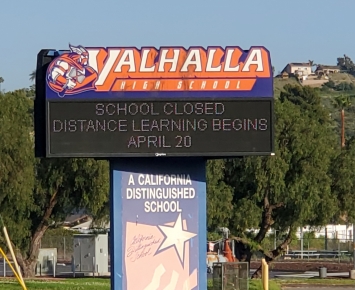
By Paul Kruze, Contributing Editor
April 24, 2020 (San Diego’s East County) -- Local East County primary and secondary school began sailing in unchartered waters earlier this week when school districts began offering distance learning for their students because of the COVID-19 virus pandemic.
East County Magazine reached out to primary and high school districts across our inland region to learn what steps they are taking to educate students remotely.
Statewide shut-down orders prompt switch to educate students at home
 Schools throughout San Diego County shut down in mid-March under order of Governor Gavin Newsom to reduce spread of the deadly illness as the number of victims grew. It had been anticipated that schools around the county would be re-opening the first week of April.
Schools throughout San Diego County shut down in mid-March under order of Governor Gavin Newsom to reduce spread of the deadly illness as the number of victims grew. It had been anticipated that schools around the county would be re-opening the first week of April.
However, on Apr. 1, Newsom announced that schools throughout the state would be closing for the remained of the academic year in response to the growing coronavirus pandemic. He said that families should operate “with the expectation now that schools will not reopen, but classes are in” for the rest of the school year for 6.1 million students statewide.
“To all of the moms, all the teachers, all the caregivers, I know how stressful this is, trust me. I know what we’re asking of you over the course of the next few months,” said Newsom, a father of school age children.
At that point several weeks ago, educators throughout the state went into extreme scramble mode trying to figure out what the “new normal” in school education will be, at least through the end of the current school year. The options range from online tutorials to packets of learning materials sent home.
How local school districts are adapting
 Lemon Grove School District begins distance learning April 27, according to the district's website. Assistant Superintendent Eddie Caballero told ECM that local educators have always discussed what to do in case of a disaster, but never did so expecting the possibility of such a long-term crisis coming to fruition.
Lemon Grove School District begins distance learning April 27, according to the district's website. Assistant Superintendent Eddie Caballero told ECM that local educators have always discussed what to do in case of a disaster, but never did so expecting the possibility of such a long-term crisis coming to fruition.
“I’ve been sitting on these planning committees since 2007 at San Diego Unified and having a conversation about the bird flu and possible pandemics and closing down schools," he said. "I guess when you sit in those meetings you never think that it will actually happen. Thirteen years later, it does happen and you’d think we’d be farther along.”
Caballero said that under the direction of the San Diego County Office of Education, instructional leader have been meeting weekly to address educational issues. “They have provided us with planning templates and sharing of resources that other districts have been utilizing and sharing best practices,” he said.
“It is really been how we best manage a situation to get equitable learning opportunities for our students. It is a range. We have families who have full internet access and their own devices which makes it very easy to interact. On the other hand, we have families which don’t have a home. How do we expect them to interact educationally as though they would be in school when they don’t have the appropriate device or the appropriate curriculum,” the Lemon Grove Superintendent continued.
“That’s going to be the biggest challenge to address – the disparity and inequity – and moving forward,” he added. “On top of that, our students with disabilities are also going to be a challenge. How do we render that service as we would normally be rendering to them in front of them?”
The Lemon Grove School District will be distributing 2,200 Chromebooks and 1,000 instructional work packets to students. “That was our first step. The time we had during spring break allowed us to get those things in place,” Caballero said. As a part of the loaner agreement the parents have to sign off on, parents have to agree to keep the Chromebooks in the best condition as possible. They will then have to return the devices at the beginning of the upcoming school year.
Local internet providers such as Cox Communications have begun to offer low cost services to low-income families. Other national communication providers including AT&T, T-Mobile, and Verizon are also offering similar services during the COVID-19 pandemic.
“Really what we are doing is referring the families to the service providers who may be able to provide them with a few months of internet service. We follow up with them and if they are not able to get internet service, that’s when we provide the instructional packets,” Caballero said.
One of the other challenges the district faces along with their counterparts is making sure that students actually do the classroom work. Caballero said that this is one major obstacle that Lemon Grove and other districts will be encountering. Because the learning environment is as it is, mandates will be more difficult. “We kind of are taking a maintenance approach where we maintain the academic levels of the students. We know that this environment is going to be very different. And how we are going to interact with students is going to be a challenge, to say the very least. “
Bradley Johnson, superintendent of the Dehesa School District, echoed Caballero’s concerns.
“Technically we cannot enforce and hold students accountable during this time, however we are highly encouraging cooperation from students and families for our distance learning program. We are setting clear expectations about the learning model, providing some routine and some flexible scheduling for school work, and some required check-ins. Since the state has waived testing and instructional minutes, we are going to review student's work using various assessments -- again, no specific grades provided,” Johnson said.
 The Mountain Empire School District has taken a similar approach in its distance learning program. Besides an extensive Chromebook program which has allowed every student to have a device, all grade levels have curated work packets that will be distributed to students which are also available online to download.
The Mountain Empire School District has taken a similar approach in its distance learning program. Besides an extensive Chromebook program which has allowed every student to have a device, all grade levels have curated work packets that will be distributed to students which are also available online to download.
The packets contain two weeks worth of grade level work to be completed at home. Every two weeks the packets will be collected by teachers and new ones distributed. Teachers are available online or via telephone to consult with students during this time.
“However, we understand that internet access is not necessarily available to all families because of the rural nature of our district. We have, therefore, created work packets that can be completed either online or in a paper version,” said Dr. Kathy Granger, Mountain Empire’s Superintendent (photo, right).
Although the Cajon Valley Union School District did not respond to East County Magazine’s request for information regarding its distance learning program, NBC San Diego’s Rory Devine recently profiled the district in a news report. Students are given assignments via a “playlist” which they are accustomed to using at the tech-oriented school. Students then have contact via Google Chat or Zoom with their teacher who is their “advisor.” The student checks in one or two times a week to make sure they are satisfactorily completing their assignments.
T ami Johnson, identified in the news report as a counselor, says, “Because we recognize that connection and the relationship as being so incredibly important for students in this new learning model, we actually changed our model so all teachers are now advisors. They are responsible for 35 students.” If a student at Cajon Valley is having difficulty with an assignment, they can have a tutoring session with their subject teachers.
ami Johnson, identified in the news report as a counselor, says, “Because we recognize that connection and the relationship as being so incredibly important for students in this new learning model, we actually changed our model so all teachers are now advisors. They are responsible for 35 students.” If a student at Cajon Valley is having difficulty with an assignment, they can have a tutoring session with their subject teachers.
Despite the district’s efforts, not everyone is satisfied. A Cajon Valley parent, who asked not to be identified, told East County Magazine that many parents after one week are not satisfied with the district’s distance learning program.
“My son’s teacher did a show-and-tell experience for one hour. That’s all he got. I know there are many parents who are pretty upset on how they are handling this,” he stated.
Grossmont Union High School District referred East County Magazine to it website. Grossmont spokesperson Catherine Martin indicated that the district has provided Chromebooks to its students for the past six years. It has created opportunities for students to exchange damaged devices for new ones.
On its Facebook page, The GUHSD announced on April 2, “Students and Parents: Distance Learning launches in GUHSD on April 20th. Check out our Distance Learning Student and Family Overview.”
But some parents have posted concerns about the GUHSD distance learning program on the district’s Facebook page.
Maria Rodriguez stated, “My son’s is about 2 hrs. per 5 classes a week. So 10 hrs. Seems weird. My middle schooler and elementary student have more work than my senior.”
Jason Gustaveson wrote on April 20, the first day of online instruction,“After seeing this district's distant learning program, only having 2 hours on one subject a week is an absolute JOKE!” He noted that the district has had weeks to prepare for distant learning, adding, “Come election time I along with many other parents will be voting in people that actually care about the student body.”
The COVID-19 pandemic has clearly proven challenging for educators facing a myriad of difficulties as they learn new ways of teaching students remotely - challenges made even more daunting for districts with many low-income famliies, English as a second language learners, homeless students, and students without high-speed internet access. Online instruction may also pose challenging for some teachers attempting to maintain instruction for students while also helping their own children at home during the pandemic stay-home orders.
Fortunately for high school seniors, the University of California and California State University systems have waived some admission requirements to assist students impacted by school shutdowns during the pandemic.
Copyright ©2020 by PaulKruzeLive.com. All Rights Reserved.
Follow Paul Kruze at facebook.com/paulkruze and Twitter @paulkruzenews








Recent comments